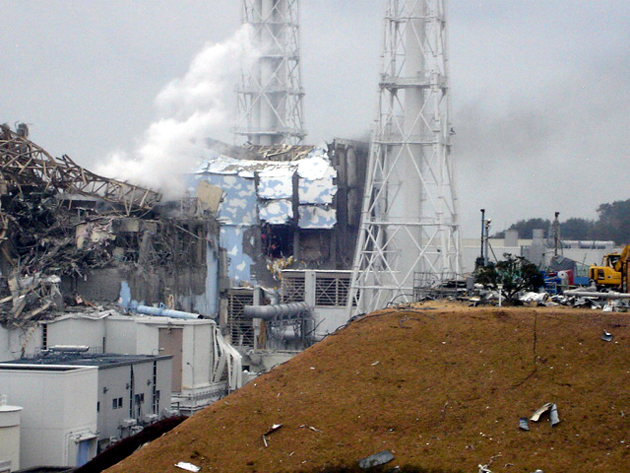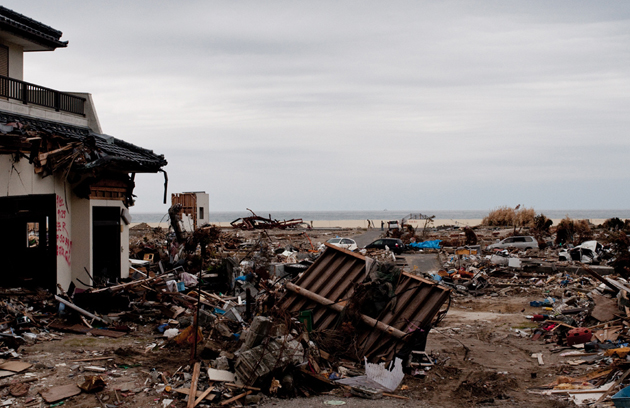This story was originally published by the Guardian and is reproduced here as part of the Climate Desk collaboration. The article was reported by the Guardian‘s Suzanne Goldenberg, and the video was produced by Climate Desk’s James West.
The first time it occurred to James Jackson that there could be lasting damage from his US Navy service during Japan’s tsunami and nuclear disaster came when his eldest son, Darius, was diagnosed with leukemia.
Darius, now 15, spent a month in hospital in early 2013, soon after his diagnosis. “I thought I was going to have to bury him,” Jackson recalled. The teenager who aspired to play college basketball now has a catheter in his chest and is too frail to run the length of the court.
Jackson, a Navy information technologist, was stationed with his family at Yokosuka, Japan, when an earthquake and tsunami knocked out the cooling systems at the Fukushima nuclear plant in March 2011, causing a triple meltdown.
He acknowledges he can’t know for sure why Darius got leukemia—but Jackson remains convinced there is a connection to the radiation escape from the Fukushima disaster, and he blames the Japanese electric company, Tepco.
On August 25, a district court judge in San Diego will decide whether the Jacksons—and around 110 other US Navy sailors and Marines—can proceed with a $1 billion lawsuit that accuses Tepco of failing to avoid the accident and of lying about the levels of radiation from the stricken reactors, putting US personnel at risk.
“I don’t think the Navy or the United States government would have let us stay there in the region. They would have gotten us out of there probably within the first 48 or 72 hours if they knew then what they know now,” Jackson said. “The issue is that we have this large company, this large enterprise, feeding the Japanese government and the rest of the world bad information. They could have come to the forefront and said, ‘Hey we need help,’ instead of trying to put a blanket over it.”
RELIEF EFFORT
Some 77,000 US Navy sailors and Marines took part in the huge relief effort after Japan’s cascading disasters, called Operation Tomodachi, or friend.
The 110 sailors suing Tepco represent only a small fraction of that number, and the lawsuit does not have the support of the US Navy establishment. The Navy maintains US sailors serving in Japan received only small, non-harmful doses of radiation. Medical experts also say radiation levels were too low to harm those involved.
“Radiation exposure to US personnel supporting Operation Tomodachi did not present any risks greater than risks normally accepted during everyday life,” Lt. Chika Onyekanne said in an email.
But the lawsuit—and a number of unexplained illnesses among veterans of Operation Tomodachi—have attracted attention in the United States, especially among anti-nuclear activists.

The lawsuit alleges a number of the sailors and their children suffered thyroid and other cancers, leukemia, birth defects, and a variety of medical conditions including infertility after they were exposed to dangerous levels of radiation. Some of the sailors were also diagnosed with post-traumatic stress disorder. One of the sailors named in the lawsuit, helicopter mechanic Theodor Holcomb, who served on the USS Reagan aircraft carrier, died of a rare cancer on April 24. The lawsuit seeks $1 billion for a medical monitoring and treatment fund.
The case is one of a number of lawsuits brought against Tepco in US and Japanese courts after the accident on March 11, 2011.
An earlier suit brought by the sailors was dismissed in April. Tepco said: “It is wholly implausible…to posit that military commanders in charge of thousands of personnel and armed with some of the world’s most expensive equipment relied instead only on the press releases and public statements of a foreign electric utility company.”
A judicial panel in Japan on July 31 said three former Tepco executives should face criminal charges for the disaster, finding they overlooked the risk of an earthquake or tsunami, and failed to take adequate measures to prevent an accident.
Several investigations since the accident have found that Tepco and Japan’s nuclear regulator failed to bring the Fukushima plant up to international safety standards.
Researchers at the Carnegie Endowment for International Peace in 2012 found that Tepco and the regulatory agency failed to plan for major earthquakes or tsunamis and that the meltdown could have been prevented if the company had taken steps to protect an emergency power supply for the reactor’s cooling system.
An investigating commission appointed by the Japanese parliament found Tepco and government regulators were overconfident and failed to invest adequate time and money to prepare for earthquake or a nuclear meltdown. The 2012 commission report rejected Tepco’s argument that the tsunami was impossible to predict, saying this was based on a “safety myth.” The commission also said Tepco tried to hide data regarding damage to the reactors.
The current case hinges on whether the court in San Diego agrees that Tepco should have done more to avoid a meltdown, according to their lawyer, Charles Bonner.
“This case to do with the fact that Tepco, this multitrillion dollar company…did not do enough to eliminate the foreseeable risk to anyone of dealing with the hazards of a nuclear meltdown,” Bonner told the Guardian.
The sailors and Marines suing Tepco also have to prove that radiation exposure was a substantive factor in their illness, Bonner said. Lawyers for Tepco refused to comment on the case.
RADIOACTIVE CLOUD
When the 9.0 earthquake struck Japan, unleashing a 14-meter (46-foot) tsunami, the US Navy immediately mobilized the US aircraft carrier, USS Ronald Reagan, and sailors at its bases in Japan, for a relief effort.
As the Reagan neared the coast of Japan, it was enveloped in a radioactive cloud. The commander put the ship in lockdown, advising sailors not to drink or shower in the water, and ordering them to stay below deck.
At the time, Lt. Steve Simmons was in peak physical condition. He spent his off-duty hours on the Reagan doing P90X insanity workouts. He said he initially accepted his commanders’ assurances that there was no threat from the radiation. “I could say I was foolish and pushed the ‘I believe’ button, because those who were telling us that were supposed to know what they were doing,” he said. “I later found just a couple of months ago that they were picking up radiation levels on the ship 30 times higher than what Tepco had reported.”
By late 2011, Simmons, now 36, was back in the United States, with his wife and three children, and driving to work in the northern Virginia suburbs when he experienced a blackout. The episode—accompanied by high fevers, swollen lymph nodes, and muscle spasms—was the start of a physical deterioration that, by the time of his retirement from the Navy last month, left Simmons confined to a wheelchair.
Military doctors have yet to reach a diagnosis on his deteriorating condition, Simmons said. But he and his wife, Summer, are convinced it was caused by radiation poisoning. “Nobody can change the fact of what happened but they can change how people are taken care of,” he said. “A lot of the Marines and sailors suffering from ailments, they were young. They don’t have the privilege of having 10-plus years in the service, fighting different bureaucracies, trying to get help with their medical bills.”
On shore, sailors like Jackson and Mike Sebourn, an aviation maintenance chief based in Atsugi, Japan, were also mobilized for the relief effort. In early April, Sebourn was promoted to radiation decontamination officer, issued with a handheld radiation device, Tyvek suit, and respirator, and charged with cleaning up helicopters flying relief missions into the tsunami zone. “I was the guy on the ground taking the background readings every day.”
He felt no ill effects at the time, Sebourn said. But his son Kimi, who was then eight, went through bouts of extreme nausea and severe nose bleeds, missing a month of school. “The kid could not stop throwing up, over and over and over. It happened every single day, at least once a day, and sometimes twice a day,” he said. “Not knowing what was wrong with my son was absolutely heartbreaking and just tore me up inside.”
By the time Sebourn left the Navy in December 2012, his own health had started to decline. He was diagnosed with PTSD. He also had unexplained muscle loss that left his right arm and leg much smaller than his left.
Sebourn admits his ailments may have nothing to do with the nuclear disaster, but he can’t help thinking a connection could emerge over time. “My biggest concern is what the future holds,” he said. “What I worry about is 10 or 15 years down the road, do I come down with radiation sickness, or do I come down with cancer, or does my son come down with cancer? I certainly hope not, but what happens?” he said. “If the worst does happen, am I going to be taken care of?”
But the sailors and Marines have a difficult challenge ahead. A peer-reviewed US Navy medical study, conducted at the request of Congress, concluded there was no evidence that the sailors aboard the Reagan or at other Navy sites in Japan had received radiation doses that would put them at higher risk of cancer and other diseases.
Indeed, the study found incidence of some cancers was lower among sailors aboard the Reagan than in the general population.
“There is no objective evidence that the Ronald Reagan sailors experienced radiation exposures during [the operation] that would result in an increase in the expected numbers of radiogenic diseases over time,” the study said. “The estimated radiation doses for all individuals…were very small and well below levels associated with the occurrence of adverse medical conditions.”
Two independent radiation experts who reviewed the study for the Guardian said they agreed with the conclusions.
Jonathan Links, an environmental health sciences professor at Johns Hopkins University and a consultation on radiation terrorism to the city of Baltimore, said the average eight millirem (mrem) radiation dose received by the sailors was equivalent to eight chest X-rays with modern equipment. “By way of comparison, all of us in Baltimore receive a yearly dose from background radiation of over 300 mrem,” he wrote in an email.
He also said the elapsed time between exposure to a carcinogen and development of cancers was generally far longer—at least five years for leukemia—than that experienced by the US sailors.
Paddy Regan, professor of nuclear physics at the University of Surrey and an expert witness for nuclear test victims against the UK government, said he had the greatest sympathy for the sailors.
It was clear some were suffering, he said. But the number of cancers among USS Ronald Reagan sailors did not in themselves indicate dangerous levels of radiation during the disaster.
“If all of these sailors were exposed to a similar amount of radioactivity and it was above the threshold that definitely causes cancer, you would expect there to be a statistically significant spike,” he said. “It wouldn’t just be one or two people who had cancer.”
The sailors, for their part, say they are prepared for a long hard fight—and for the prospects of a backlash from some of their former shipmates.
For Darius, however, he just wants his illness to be over, and for ordinary life to resume. He is still undergoing treatment for leukemia, still stuck in hospital instead of spending time with his friends. “I just want to get through all of this so I can start playing sports for high school,” he said. “I want this just to go away, and to just fast forward the next four years so I can play all the sports I want.”













